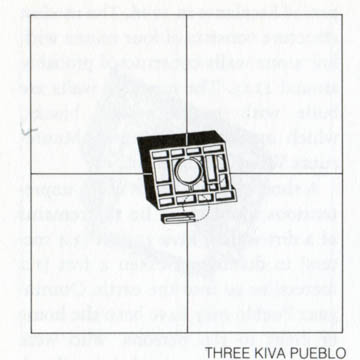Located in Montezuma Canyon in southeastern Utah, Three Kiva Pueblo lies approximately 50 miles northwest of Mesa Verde, Colorado. It is an example of small-scale communities that lived in the four corners region of Utah more than 1,200 years ago. The site contains a single-story Anasazi pueblo with fourteen rooms, a kiva, and a turkey pen. The surrounding terrain consists of rugged mesas and arroyos with occasional willows and cottonwoods.
The first part of Three Kiva Pueblo was probably built in 800. The earliest occupants seem to have been affiliated culturally with the Kayenta branch of the Anasazi, who lived to the south and west. Following three successive occupations, the pueblo was apparently abandoned around 1300. Later influences at the site appear to be more closely associated with the peoples of Mesa Verde and nearby Hovenweep, both powerful cultural centers of the time.
The rooms of the pueblo form a rectangle measuring at most 37 x 50 feet. A short distance to the south is an elongated stone enclosure some 20 feet long and 2 feet wide; it is believed to have been a turkey pen. An abundance of turkey bones at Three Kiva Pueblo suggests that the domesticated bird was an important source of meat and feathers.
The room sizes of the pueblo range from 42 to 165 square feet. In the center of the room block is an enclosed kiva with an interior diameter of possibly 14 feet. Two additional kivas are thought to have existed at the site and are included in reconstructed plans of Three Kiva Pueblo. On site, only one kiva has been reconstructed. Dashed lines in the reconstructed plan represent two additional kivas.
Archaeologists from Brigham Young University have conducted extensive excavations at the site. Among their discoveries were two abalone shell pendants, indicating trade contacts with the Pacific Coast. Stone artifacts also were found, including knives, scrapers, drills, projectile points, hammer stones, hoes, axes, mauls, dishes, manos, and metates.
References
Morgan, William N. Ancient Architecture of the Southwest. Austin: University of Texas Press, 1994.
Noble, David Grant. Ancient Ruins of the Southwest: An Archaeological Guide. Flagstaff, AZ: Northland Publishing, 1991.














